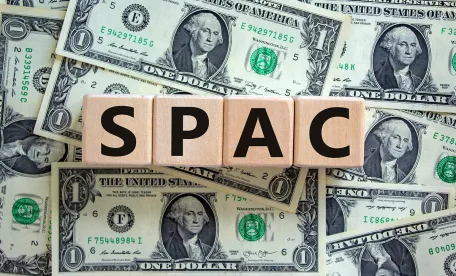The Inflation Reduction Act of 2022, which was signed into law on August 16, 2022, enacted a new 1% excise tax on certain repurchases of the stock of publicly traded corporations, codified in Section 4501 of the Internal Revenue Code of 1986 (the Excise Tax).
A “repurchase” subject to the Excise Tax is generally defined as (A) a redemption, or (B) an “economically similar” transaction.[1] For additional background on the Excise Tax, see our previous alert here.
Since its enactment, the Excise Tax has been viewed as a significant development for all publicly traded corporations but has become a matter of significant concern for publicly traded special purpose acquisition companies (SPACs) in particular. A SPAC raises cash for the purpose of acquiring an operating company (any such acquisition is typically referred to as a “de-SPAC” transaction). A SPAC’s shareholders generally have a redemption option that may be exercised in connection with a de-SPAC transaction. If a SPAC does not find a suitable acquisition target within a certain period of time (generally not more than two years), then it is typically required to liquidate.
SPACs and their advisors have been watching intently for guidance on the Excise Tax, which finally arrived on December 27, 2022, mere days before the Excise Tax was set to take effect in the form of interim guidance from the US Department of the Treasury and the Internal Revenue Service (IRS) set forth in Notice 2023-2.
Notice 2023-2
The Notice states that Treasury and the IRS intend to issue proposed regulations addressing the application of the Excise Tax and describes the rules that Treasury and the IRS anticipate including in those regulations, together with 26 examples of the application of those rules.[2] Until the forthcoming proposed regulations are issued, taxpayers may rely on the operating rules set forth in the Notice.[3] The Notice also describes the anticipated procedural rules for reporting and paying Excise Tax liabilities, requiring the reporting of the Excise Tax for a given tax year on the Form 720 (together with a dedicated form for the Excise Tax, which is expected to be the new Form 7208, a draft of which was released by the IRS on December 28) that is due for the first full quarter after the close of the year, with the Excise Tax being payable on the filing deadline for that Form 720.[4]
The Notice anticipates that the forthcoming proposed regulations will provide that rules consistent with the operating rules in the Notice generally will apply to stock repurchases made after December 31, 2022, and to issuances of stock made during a taxable year ending after December 31, 2022.[5] Finally, Treasury and the IRS invite comments from the public on a number of specific questions identified in the Notice, addressing rules both included and not included in the Notice.[6]
The Notice provides welcome relief for SPACs by generally excluding from the application of the Excise Tax any distribution in complete liquidation of a covered corporation (which typically would include a publicly traded SPAC).[7] Except as discussed below under “Complete Liquidation,” redemptions in connection with a de-SPAC transaction, however, continue to be included in the tax base for the Excise Tax, which is generally the aggregate fair market value of repurchases in connection with any such redemption during the taxable year, reduced by the fair market value of stock issued pursuant to the “Netting Rule” described below.
Complete Liquidation
Under the Notice, a distribution in complete liquidation of a SPAC is not an “economically similar” transaction, and is therefore exempt from the Excise Tax.[8] The Notice also appears to exclude from the Excise Tax any distribution during the tax year in which a SPAC liquidates by including such distribution in the list of transactions that are not “economically similar,” and stating that such distribution is not a “repurchase.”[9] The Notice does not appear to explicitly require that such a distribution be made in connection with the liquidation, provided that the distribution and the liquidation occur in the same taxable year. Therefore, it would seem that, if (A) a SPAC redeems its stock in anticipation of the closing of a de-SPAC transaction, (B) the transaction does not close, and (C) the SPAC instead liquidates during the year in which the redemption occurs, distributions in connection with such a redemption may be exempt from the Excise Tax. However, there is some ambiguity in the drafting of this exception.[10] The IRS hopefully will clarify in future guidance that a “distribution” covered by this exception includes a distribution in connection with a redemption, and not only a distribution that is “economically similar” to a redemption.
Netting Rule
As noted above, a SPAC’s Excise Tax base is generally reduced by the aggregate fair market value of any stock that the SPAC issues during the taxable year (the Netting Rule).[11] In a typical domestic de-SPAC transaction, a SPAC acquires a corporate target using (A) a reverse triangular merger, pursuant to which the SPAC’s newly formed merger subsidiary merges into the target, (B) a “two-step merger,” pursuant to which, in step one, a SPAC’s newly-formed merger subsidiary merges into the target, and, in step 2, the target merges into a newly formed limited liability company that is wholly owned by the SPAC, or (C) a forward merger pursuant to which the target merges into the SPAC. In connection with any of the foregoing merger structures, the SPAC generally issues new stock in the SPAC to the target’s shareholders as consideration, redeems shareholders in the SPAC that exercise their redemption option, and sells new stock in the SPAC in a “private investment in public equity” (PIPE) transaction. In computing a SPAC’s Excise Tax base under the Netting Rule, the aggregate fair market value of the shares issued to the target’s shareholders (if the target is not publicly traded) and to the PIPE purchasers may generally be netted against, and is often expected to fully offset, the fair market value of the redeemed shares. If the fair market value of the redeemed shares is fully offset under the Netting Rule, then there is generally no Excise Tax in connection with the redemption.
However, if the target is publicly traded, then the SPAC’s shares that are issued to the target’s shareholders may not be used to reduce the SPAC’s Excise Tax base.[12] Under current market conditions, the volume of any PIPE issuance is expected to be significantly less than (and insufficient to fully offset) the volume of redemptions. Therefore, if the above de-SPAC structure involves a publicly traded target, the SPAC may not fully benefit from the Netting Rule and a significant portion of the redemption may be subject to the Excise Tax.
Certain other common de-SPAC structures do not benefit from the Netting Rule altogether under the Notice. One of the structures generally known as a “double dummy” involves a newly formed publicly traded holding company acquiring both a SPAC and a target and is often utilized in flow-through target acquisitions. The holding company forms two merging subsidiaries (i.e., dummy companies), one of which merges into the operating target company and the other merges into the SPAC. In the double dummy structure, the new holding company, rather than the SPAC, issues stock to PIPE investors and target shareholders — under the Notice such stock issuances are not permitted to reduce the Excise Tax base of a SPAC.[13] A similar issue arises in the context of a publicly traded target company acting as the acquiror of the SPAC — any stock issued by such target, including stock issued to PIPE investors, may not reduce a SPAC’s Excise Tax base.
Further guidance from Treasury and the IRS on the Excise Tax is expected in the form of proposed regulations, which may address additional lingering questions relating to the Excise Tax not covered by Notice 2023-2, although the timing of the issuance of any such guidance is not clear at the moment.




 />i
/>i

